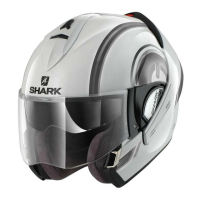2928
SYSTÈME D’AÉRATION
Ventilation supérieure :
La prise d’air supérieure (Fig. A) permet
une entrée d’air sur la partie haute de
la tête et ainsi de renouveler l’air de la
coiffe. Les canaux intégrés aux éléments
amortisseurs internes facilitent la circu-
lation de l’air sur la surface de la tête.
La qualité et la conception des textiles de
confort participent à la bonne diffusion
de l’air. La position de la ventilation su-
périeure est déterminée afin d’optimiser
l’efficacité de sa prise d’air. Selon le
type de votre machine, le carénage peut
amoindrir l’efficacité de cette ventila-
tion.
La ventilation est en position ouverte une
fois la languette poussée vers l’arrière ;
fermée, la languette est poussée vers
l’avant (Fig. B).
Ventilation inférieure (mentonnière) :
Cette prise d’air a pour fonction princi-
pale de diriger un flux d’air frais sur la
surface intérieure de l’écran afin de li-
miter les risques de formation de buée.
L’air frais diffusé coupe le contact de
l’air chaud émis par le souffle ou même
la tête à l’intérieur du casque.
Sur cette ventilation également, la pré-
sence d’un carénage peut nuire à son
bon fonctionnement. Dans des condi-
tions météorologiques extrêmes (par
exemple fortes pluies, grand froid…),
le risque de formation de buée est plus
grand, nous vous conseillons, dans ce
cas, d’utiliser l’écran dans sa position
entrouverte.
La ventilation est en position ouverte une
fois la languette poussée vers le bas ; fer-
mée, la languette poussée vers le haut
(Fig. C).
SYSTEM OF AERATION
Upper ventilation:
The upper air intake (Fig. A) allows air
to enter onto the upper part of the head
and thus renew the air in the head sec-
tion. The channels incorporated in the
internal shock absorbers facilitate the
circulation of air over the surface of the
head.
The quality and design of the textile
comfort parts contribute to the proper
distribution of air. The position of the
upper ventilation system is designed to
optimise the effectiveness of its intake
of air. Depending on the type of your
motorbike, the fairing may reduce the
effectiveness of this ventilation.
The ventilation is in the open position
when the tongue is pushed backwards
and closed when the tongue is pushed
forwards (Fig. B).
Lower ventilation (chin section):
The principal function of this air intake
is to direct a flow of fresh air over the
interior surface of the visor in order to
limit the risk of misting. The fresh air
diffused cuts off contact with the hot
air emitted by breathing or even by the
head inside the helmet.
The presence of fairing may also reduce
the effectiveness of this ventilation.
In extreme weather conditions (for
example, under heavy rain or extreme
cold, etc.) the risk of misting is greater
and we advise you, under these condi-
tions, to use the visor slightly open.
Ventilation is open when the tongue is
pushed downward and closed when it is
upward (Fig. C ).
WARNING! Do not open or
close any vents while opera-
ting your motorcycle. You could lose
control of your motorcycle, resulting in
an accident, personal injury or death.
ATTENTION! Ne manipulez
pas ces ventilations pendant
que vous conduisez. Vous pourriez
perdre le contrôle de votre moto, cau-
sant ainsi un accident, des blessures
corporelles ou la mort.
A
B
C

